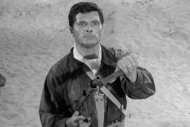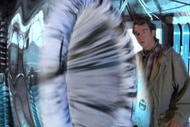Create a free profile to get unlimited access to exclusive videos, sweepstakes, and more!
Emmy Contender: Into the blinding tunnel of The Man in the High Castle's own multiverse

Welcome to Emmy Contenders 2019. This month, SYFY WIRE is speaking to a long list of actors, artists, and artisans whose work earned them Emmy nominations this year. Today we speak with Drew Boughton (production designer) and Gonzalo Amat (cinematographer), who are nominated for Amazon's The Man in the High Castle.
"Welcome to the gateway to the multiverse," says Dr. Josef Mengele, greeting visitors to the tunnel deep within a Pennsylvania coal mine. In the world of The Man in the High Castle, this gateway — a quantum tunneling device — is the center of Projekt 701, aka Die Nebenwelt (The Other World), and it is meant to enable travel between alternate worlds — ideally, to conquer them for the Third Reich. The underground facility, near a mysterious portal called The Anomaly, is meant to contain energy from a blast; when activated, it emits a blinding light and an unusually intense electromagnetic field. (And if it malfunctions, its destructive force would be equivalent to that of a small atomic bomb.)
You might think of it as a Nazi StarGate.
"It's actually one of my favorite sets," production designer Drew Boughton tells SYFY WIRE. "In our show, people can go from one multiverse to another in two ways. One is spiritual, through the decency and goodness of the person, using meditation. And then the other is through science, through brutality, forcing their way through."
During early conceptual meetings, the team struggled to find a satisfying idea about how to visually portray going from one universe to another. What they settled on was the light — the test subjects would go into the light, disappear, and come out the other side. They also decided it shouldn't be CGI, but a giant, practical lighting effect, to create real shadows interacting with the subject (essential for the show's signature silhouette shots).
It fell to cinematographer Gonzalo Amat to capture the finale's visual intensity, starting with a low pulsating light building to lightning strikes and then climaxing in a blinding flash. Even though the scene depicts a supernatural event, the idea was to keep the effect's look within the scientific world of physics, in terms of the way light behaves and how particle accelerators operate. "We didn't want anything that seemed electronic, like a laser," Amat explains.
In order to see the end of the tunnel (which was streaked with wet spots so lights could pick up texture), Amat put a mirror at one end with circular lighting right above it. He also extended the tunnel's virtual length with special lenses.
The lighting setup required more than a million watts — so much power that no other set at the Vancouver studio was able to use power at the same time.
"All the power had to be dedicated to the tunnel set," Amat says. "But it was pretty awesome because with all that light, it just really feels like you're looking at something that's not natural, you know? It's almost like a live thing in there."
Although they had the ability to do so, the production never went full blast. If the full million watts had been used for more than 30 seconds, they would have burned holes into the plastic of the tunnel set. As it was, sunglasses had to be worn for eye protection.
"It's like looking at a flash," Amat says, laughing. "You'd have a little bit of a blinding moment, and then you'd be okay. It's not as bad as it sounds."



























